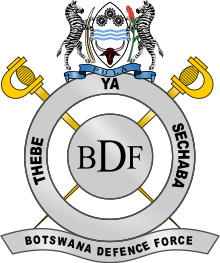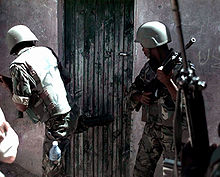Botswana Defence Force
| Botswana Defense Force | |
|---|---|
 Botswana Defence Force emblem | |
| Motto | Thebe Ya Sechaba |
| Founded | 1977 |
| Current form | 2020 |
| Service branches | Botswana Ground Force BDF Air Wing |
| Headquarters | Gaborone |
| Website | BDF Website |
| Leadership | |
| President | Mokgweetsi Masisi |
| Minister of Defence, Justice, and Security | Shaw Kgathi |
| BDF Commander | Major General Molefi Seikano |
| Manpower | |
| Military age | 18 |
| Available for military service | 1,230,000, age 18–44 |
| Fit for military service | 871,381 males, age 18–44, co females, age 18–44 |
| Reaching military age annually | 19,000 |
| Active personnel | 9,000[1] (ranked 128th) |
| Deployed personnel | 50 |
| Expenditures | |
| Budget | $572 million (2018)[1] |
| Percent of GDP | 2.99% (2018)[1] |
| Industry | |
| Foreign suppliers | France United States Russia Germany Israel |
| Related articles | |
| History | Military history of Botswana |
| Ranks | Military ranks of Botswana |
The Botswana Defence Force (BDF, Setswana: Sesole Sa Botswana), the military of Botswana, formed in 1977. The commander-in-chief is Mokgweetsi Masisi. The main force is the army; there is also an air wing, but no sea-going navy, although there is a river contingent attached to the ground forces, with 10 Panther airboats and 2 Boston Whaler Raider class.[2][3][4]
History[edit]
At independence in 1966, Botswana made a decision to not establish a standing military and focus instead on development and poverty alleviation, and instead created a small military police force for security.[5] However, cross border incursions by Rhodesian and South African security forces in the mid-1970s led the government to conclude that the country needed a military to protect its sovereignty.[citation needed] The BDF was established in 1977. Following political changes in South Africa and the region, the BDF's missions have increasingly focused on anti-poaching activities, disaster-preparedness and response (including search and rescue), support to civil authorities and foreign peacekeeping. A well respected institution trusted by the political leadership, the BDF has seen its role increase over time to include non-traditional missions such as disaster response and reinforcement of the police during the holiday season and high crime periods. The BDF's professionalism and ability to successfully accomplish any task the government gives it has, at times, resulted in over tasking in support to civil authorities.[citation needed] In 2015 the BDF recruited its first female privates.[6]
Organisation[edit]
Botswana Defence Force consists of three separate service components each of which is commanded by a major general:
- 1BDE GROUP, consists of 15inf, 12inf, 114medium artillery and 114 service support battalion.
- Air Arm command, has its own signals, logistics(HQ at Thebephatswe Air Base) and
- Defence Logistics Command (HQ at Sir Seretse Khama Barracks (SSKB) in Gaborone).
- 3 brigade group, based in glen valley consist of 111 mar, 177 mechanised battalion and its logistics
The BDF Command and Staff College is located at Glenn Valley.[7]
The BDF ground forces consists of the following units:[8]
- 1 Armoured brigade
- 2 Infantry brigades (one armoured reconnaissance regiment, four infantry battalions, one commando unit, two air defence artillery regiments, one engineer regiment and one logistics battalion.)
- 1 Artillery brigade
- 1 Air Defence brigade
- 1 Engineering company
- 1 Signals company
Military education and training[edit]
U.S. International Military Education and Training funds from the USA remain important to Botswana's officer training programme. Over 50 Botswana officers receive military training in the US each year; by 1999 approximately 85% of the BDF officers are said to have been trained through this arrangement.
BDF Air Wing[edit]
The Air Wing was formed in 1977 and is organisationally part of the Botswana Defence Force. All squadrons are designated with a Z, which is used as a designation for "squadron". The main base is near Molepolole and was built by mostly foreign contractors between 1992 and 1996. The base is a multi-stage project that included runways, taxiways, extensive shelter and ordnance storage facilities, a headquarters facility and a large complex of living quarters and support buildings. Sometimes referred to as the "Eagle" project, the base has received continual improvements since its inception. Other airports used are Sir Seretse Khama International Airport at Gaborone and Francistown International Airport in Francistown.
The backbone of the Air Wing consists of a squadron of former Canadian CF-116s which are locally designated as BF-5s. Thirteen ex-Canadian CF-116s (ten single-seater CF-5As and three trainer CF-5Bs) were ordered in 1996 to replace the Strikemasters, with another three single-seaters and two dual-seaters delivered in 2000.[Note 1] The aircraft were re-designated OJ-1 through 16. For transport, the Air Wing uses Britten-Norman Defenders, CASA C-212 Aviocars, CASA CN-235s and C-130B Hercules. The latest addition to the transport fleet was an ex-AMARC C-130 Hercules to complement the two existing aircraft.[9] A combination of Bell 412EP and 412SP helicopters are operated by Z21 and perform a variety of functions; search and rescue, medevac, anti-poaching and troop & VIP transport.
Domestic operations[edit]
- 1995 – BDF undertook rescue missions during floods that hit major parts of the country.[10]
- 1996 – BDF deployed soldiers and equipment at Sua Pan in 'Operation Save Sua' to save the berm wall of Botswana Ash (Botash) plant, which was being threatened by heavy floods. The soldiers laid 90,000 sandbags and 12,000 tires in the operation.[10]
- 2006 – In the floods that hit Ramotswa and its surrounding areas in February 2006, BDF teams carried out rescue missions and saved hundreds of lives.[10]
- 2009 – BDF provided assistance during the flooding that affected a large community around the Kasane area.[10]
- 2014 – Anti-poaching operations.
International cooperation[edit]

In 1992 and 1993, a BDF contingent participated in Operation Restore Hope, a United States led coalition of forces to restore peace in Somalia. From 1993 to 1994, a team of BDF officers participated in a UN peacekeeping mission in Rwanda as observers. Those same years, BDF troops participated in United Nations Operation in Mozambique, the UN peacekeeping operation in Mozambique.[11]
The BDF also participated in Operation Boleas, a SADC military intervention in Lesotho in 1998. This operation culminated in a re-training programme for Lesotho Defence Force members. From 1998–99, 380 BDF soldiers formed part of a Southern African Development Community (SADC) task force to quell an internal uprising in Lesotho.[11] Botswana withdrew its contingent when the situation was thought to be stable enough to no longer require their presence.
The BDF has also been successfully deployed as part of the UN peacekeeping operations in both Somalia and the Darfur region of Sudan.[12]
BDF has been conducting operational exercises with Defence Forces of neighbouring countries and other friendly forces. "Exercise Thokgamo" was one such exercise conducted in June 2005 in which SADC member states participated. Currently, the BDF has its personnel serving on an African Union Liaison Mission in Ethiopia/Eritrea and has military observers in Darfur, Sudan with UNAMID.[11]
Chiefs of the Defence Staff (1966–present)[edit]
The former heads of the Botswana Armed Forces were referred to while in office as either General Officers Commanding or Chiefs of the Defence Staff.
- 1977-1989 Lieutenant-General Mompati Merafhe
- 1989-1998 Lieutenant-General Ian Khama
- 1998-2008 Lieutenant-General Louis Matshwenyego Fisher
- 2008-2012 Lieutenant-General Tebogo Masire
- 2012-2017 Lieutenant-General Gaolatlhwe Galebotswe
- 2017-Present Lieutenant-General Placid D. Segokgo
Notes[edit]
See also[edit]
Citations[edit]
- ^ a b c IISS 2019, p. 453. Harv error: no target: CITEREFIISS2019 (help)
- ^ Pike, John. "Botswana Defence Force (BDF)". www.globalsecurity.org. Archived from the original on 28 March 2018. Retrieved 28 March 2018.
- ^ Pike, John. "Botswana Navy". www.globalsecurity.org. Archived from the original on 28 March 2018. Retrieved 28 March 2018.
- ^ Martin, Guy (7 February 2013). "Botswana – defenceWeb". www.defenceweb.co.za. Archived from the original on 21 July 2018. Retrieved 21 July 2018.
- ^ "Ottawa Citizen – Google News Archive Search". news.google.com. Archived from the original on 2 November 2015. Retrieved 16 June 2015.
- ^ "allAfrica.com: Botswana: BDF Recruits First Women Privates". allAfrica.com. Archived from the original on 3 February 2015. Retrieved 3 February 2015.
- ^ BDF receives accolades for professionalism Archived 3 February 2014 at the Wayback Machine, 19 May 2013.
- ^ The Military Balance 2013 (2013 ed.). International Institute for Strategic Studies. 14 March 2013. pp. 495–496. ISBN 978-1857436808.
- ^ a b "Jane's Sentinel Country Risk Assessments Southern Africa" (26). Jane's Information Group. 2009: 94–96. ISSN 1754-9256. Cite journal requires
|journal=(help) - ^ a b c d "Printing". Archived from the original on 26 August 2011.CS1 maint: BOT: original-url status unknown (link)
- ^ a b c "Archived copy". Archived from the original on 17 August 2011. Retrieved 2011-01-10.CS1 maint: archived copy as title (link)
- ^ "IRIN • humanitarian news and analysis from Africa, Asia and the Middle East". IRINnews. Archived from the original on 23 March 2008.
References[edit]
- International Institute for Strategic Studies (15 February 2019). The Military Balance 2019. London: Routledge. ISBN 9781857439885.
Further reading[edit]
- Boubacar N'Diaye, The Challenge of Institutionalizing Civilian Control: Botswana, Ivory Coast, and Kenya in Comparative Perspective, Lexington Books, January 2001
- Mpho G. Molomo, 'The Trajectory of Civil-Military Relations in Botswana,' Chapter Seven of Civil-Military Relations in Developing Countries, 2013.
- Sharp, Paul, and Louis Fisher. "Inside the 'crystal ball': Understanding the evolution of the military in Botswana and the challenges ahead." Evolutions and Revolutions: A Contemporary History of Armed Forces in Southern Africa, Institute for Security Studies, 2005, 43–60.
External links[edit]
| Wikimedia Commons has media related to Botswana Defence Force. |
- Institute for Security Studies: Botswana Note: although generally a good source, this site wrongly describes Fisher as "Major General", and misspells his given name "Matshenwenyego".
- "Army Commander Accused Of Abuse" Mmegi Online 7 November 2005. Retrieved 25 February 2006. Example of correct title and spelling of commander's name.
- "Production Capability (Botswana), Nuclear"[permanent dead link] Janes Information Group|Janes CBRN-Assessments 5 September 2011. Retrieved 6 June 2012.

No comments:
Post a Comment